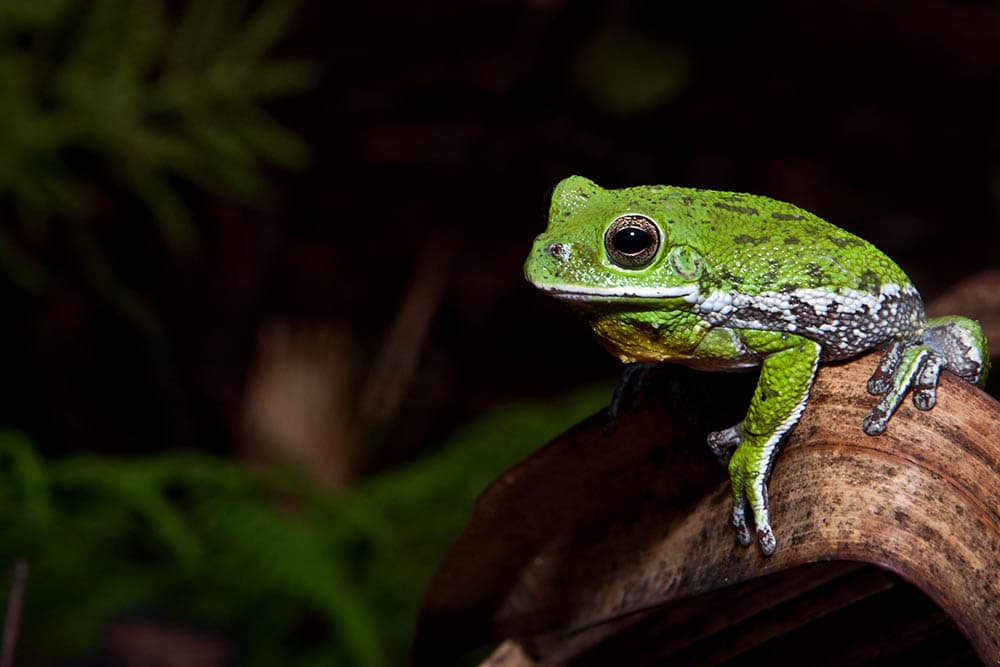If you live in Georgia or are planning to visit, it can be helpful to learn about the local wildlife, so you know a little about what to expect if you go for a walk or hike. It’s also good to know about any poisonous animals you might see. Keep reading while we list the frogs you can find in Georgia. We’ll point out the large and small ones as well as any invasive species, and we’ll also let you know which ones are poisonous so you can identify them and keep from getting injured.

The 18 Frogs Found in Georgia
1. American Bullfrog

| Species: | Lithobates catesbeianus |
| Longevity: | 10–16 years |
| Good to own as a pet?: | Yes |
| Legal to own?: | Yes |
| Adult size: | 3–9 inches |
| Diet: | Carnivorous |
The large olive-green American Bullfrog will often grow to weigh more than 1 pound, and you can usually find them on the banks of freshwater ponds and banks. While these frogs are an invasive species in much of the world, these frogs are native to the eastern United States, including Georgia.
2. Green Frog
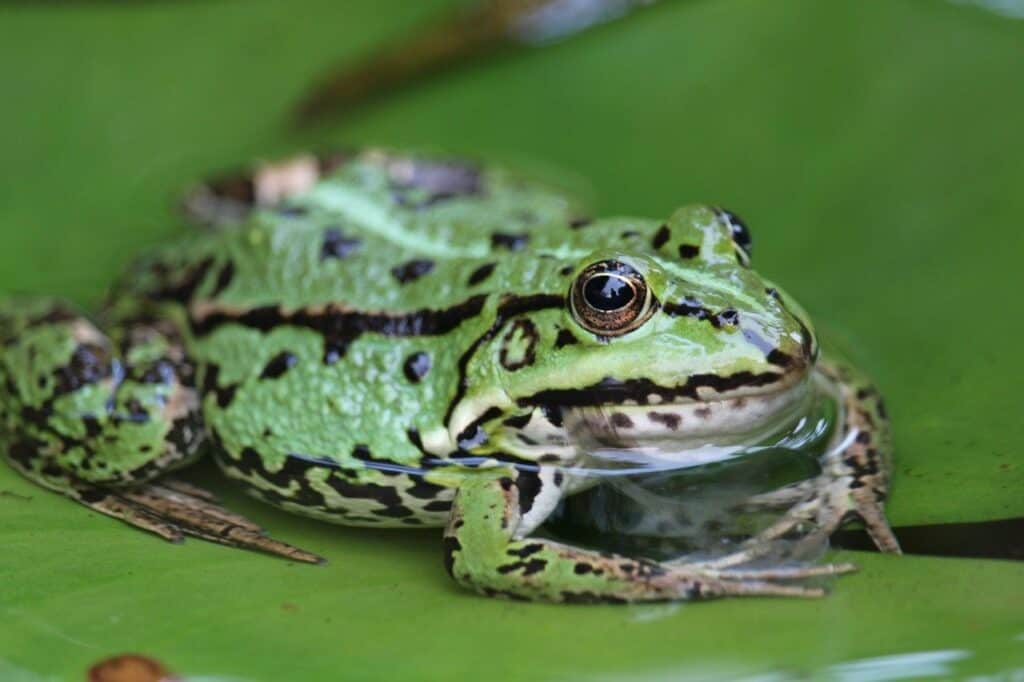
| Species: | Lithobates clamitans |
| Longevity: | 10 years |
| Good to own as a pet?: | No |
| Legal to own?: | Yes |
| Adult size: | 2–4 inches |
| Diet: | Carnivorous |
The Green Frog is another fairly large frog that you can find in Georgia. It likes shallow ponds and swamps and is more active during the day. It’s very abundant, and it can become darker in color on cold days to help it stay warm.
3. Bronze Frog

| Species: | L. clamitans |
| Longevity: | 7–10 years |
| Good to own as a pet?: | No |
| Legal to own?: | Yes |
| Adult size: | 3–5 inches |
| Diet: | Carnivorous |
The Bronze frog is quite similar to the Green Frog in appearance, except for its skin color. It also tends to be slightly larger, and its mating call sounds like someone plucking a banjo, causing many people to call it a Banjo Frog. This frog is active around the clock.
4. Spring Peeper

| Species: | Pseudacris crucifer |
| Longevity: | 3–4 years |
| Good to own as a pet?: | No |
| Legal to own?: | Yes |
| Adult size: | 1–2 inches |
| Diet: | Carnivorous |
The Spring Peeper is a smaller frog that you can find almost anywhere in the United States, including Georgia. It’s a chorus frog whose chirping call marks the beginning of spring. It’s a good climber but prefers to stay on the ground camouflaged in loose debris.
5. Grey Tree Frog

| Species: | Dryophytes versicolor |
| Longevity: | 8 years |
| Good to own as a pet?: | No |
| Legal to own?: | Yes |
| Adult size: | 1–2 inches |
| Diet: | Carnivorous |
The Gray Treefrog is a small frog that you can find all over the eastern United States. It prefers to stay in the trees until it’s time to breed when it makes its way to a nearby pond or swamp. Its skin has a lumpy texture leading many people to believe it is a toad.
6. Pickerel Frog
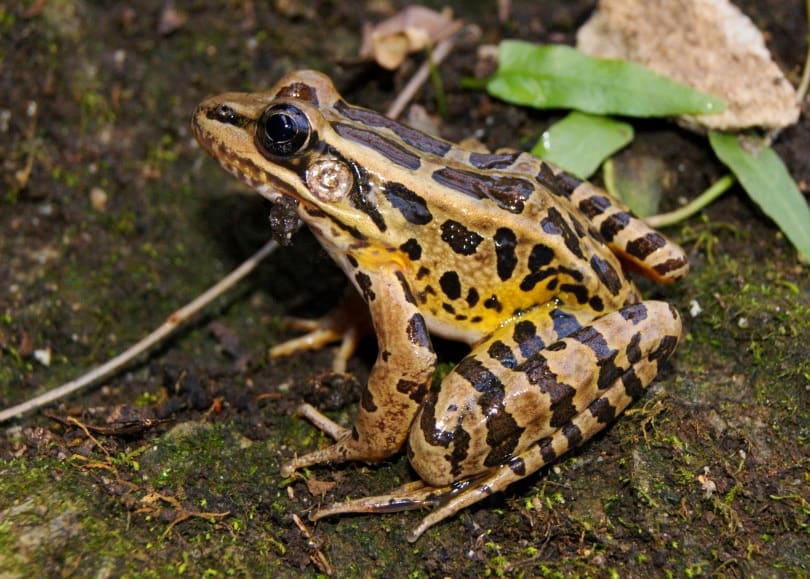
| Species: | Lithobates palustris |
| Longevity: | 5–8 years |
| Good to own as a pet?: | No |
| Legal to own?: | Yes |
| Adult size: | 1.5–3.5 inches |
| Diet: | Carnivorous |
The Pickerel Frog is the only poisonous frog native to the United States. Its skin secretes a toxin that irritates human skin and can help ward off predators. It’s a brown frog with what appears to be hand-drawn squares on its back, and the front toes have no webbing to make it easier for the frog to move around outside the water.
7. Southern Leopard Frog
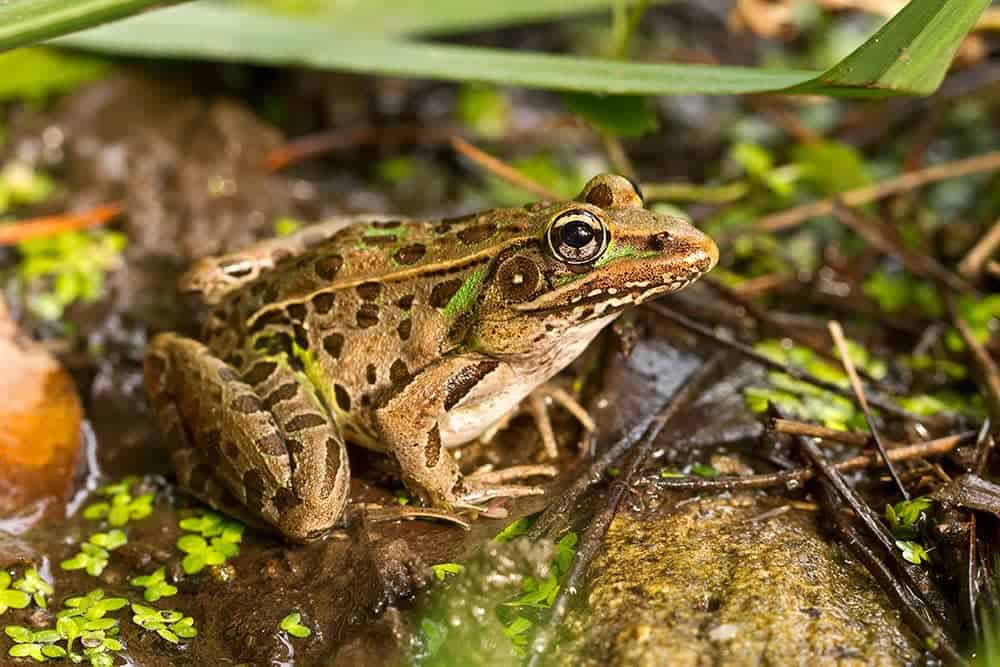
| Species: | Lithobates sphenocephalus |
| Longevity: | 3 years |
| Good to own as a pet?: | No |
| Legal to own?: | Yes |
| Adult size: | 2–4 inches |
| Diet: | Carnivorous |
The Southern Leopard Frog is a medium-sized frog that you can find all over Georgia. It has small spots over its back that give it a leopard-like appearance. This small frog is becoming an invasive species as it spreads to the Bahamas, and scientists have found a few specimens as far west as California.
8. Northern Cricket Frog
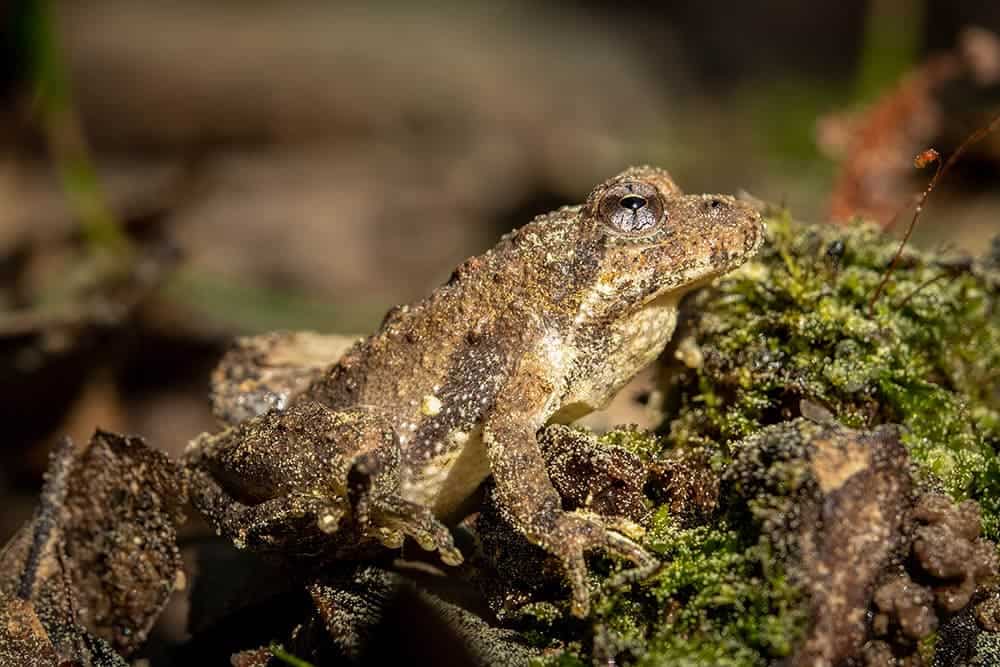
| Species: | Acris crepitans |
| Longevity: | 4–5 years |
| Good to own as a pet?: | No |
| Legal to own?: | Yes |
| Adult size: | 1.5 inches |
| Diet: | Carnivorous |
The Northern Cricket Frog is found all over Georgia except the extreme south. It’s a dark-colored frog that is a member of the tree frog family but prefers to stay on the ground amid loose debris where it can hunt. It’s a communal frog, and you will often find them in large numbers.
9. Southern Cricket Frog
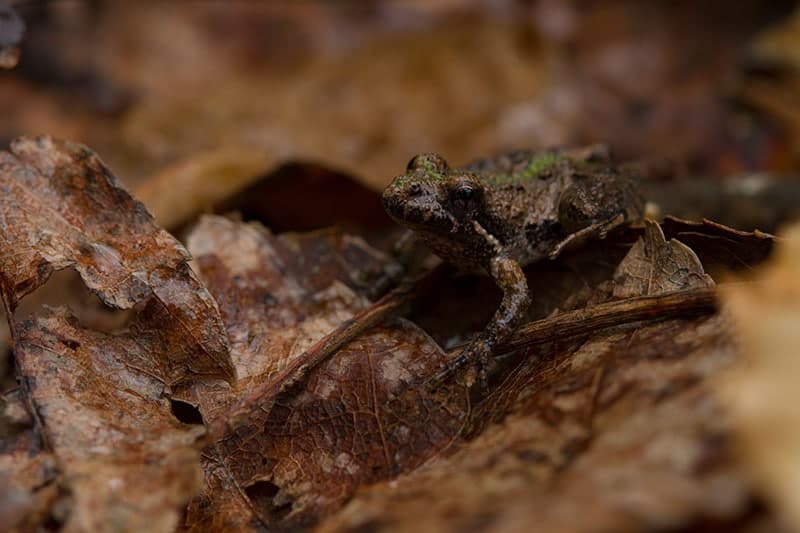
| Species: | Acris gryllus |
| Longevity: | < 1 year |
| Good to own as a pet?: | No |
| Legal to own?: | Yes |
| Adult size: | 1–1.5 inches |
| Diet: | Carnivorous |
The Southern Cricket Frog is another frog popular in Georgia. It’s a small frog with a pointed snout and a black stripe on the thigh. It can jump further than many other frogs of similar size and prefers to live near bogs and ponds.
10. American Green Tree Frog
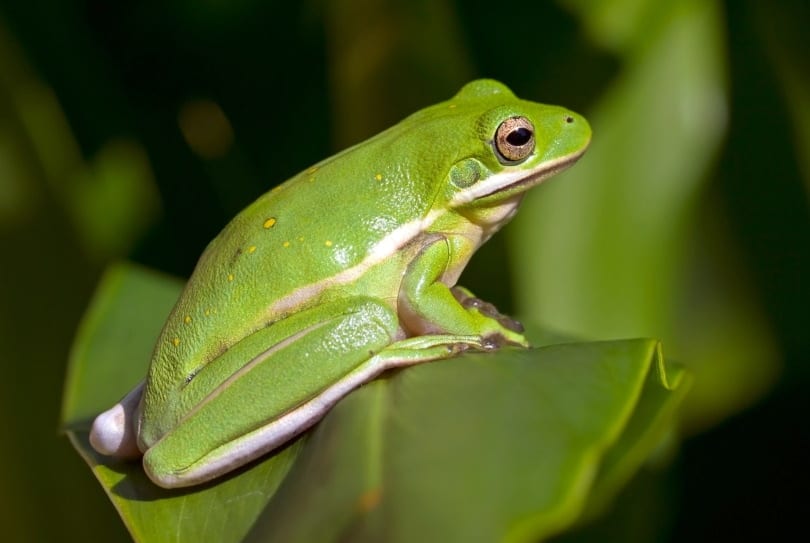
| Species: | Hyla cinerea |
| Longevity: | 2–3 years |
| Good to own as a pet?: | Yes |
| Legal to own?: | Yes |
| Adult size: | 2–3 inches |
| Diet: | Carnivorous |
The American Green Tree Frog is easy to find in the southern part of Georgia, and they are a popular pet due to their small size and low maintenance requirements. As the name suggests, these frogs enjoy climbing and require plenty of twigs and branches in their habitat.
11. Pine Woods Tree Frog

| Species: | Dryophytes femoralis |
| Longevity: | 2–3 years |
| Good to own as a pet?: | No |
| Legal to own?: | Yes |
| Adult size: | 1–1.5 inches |
| Diet: | Carnivorous |
You can find the Pine Woods Tree Frog in Southern Georgia, where it likes to stay high up in the trees of pine woods. Its appearance is similar to a Squirrel Tree Frog, but it has yellow, orange, or white dots on its thigh that are easy to see when it jumps.
12. Barking Tree Frog

| Species: | Dryophytes gratiosus |
| Longevity: | 6–7 years |
| Good to own as a pet?: | No |
| Legal to own?: | Yes |
| Adult size: | 2–3 inches |
| Diet: | Carnivorous |
The Barking Tree Frog is another species that you can find hiding in the trees and shrubbery of Southern Georgia. It can also burrow deep into the mud for protection from predators when it needs to, or it might burrow to escape the heat. It has a loud barking call that gives it its name, and it’s usually more active at night.
13. Squirrel Tree Frog
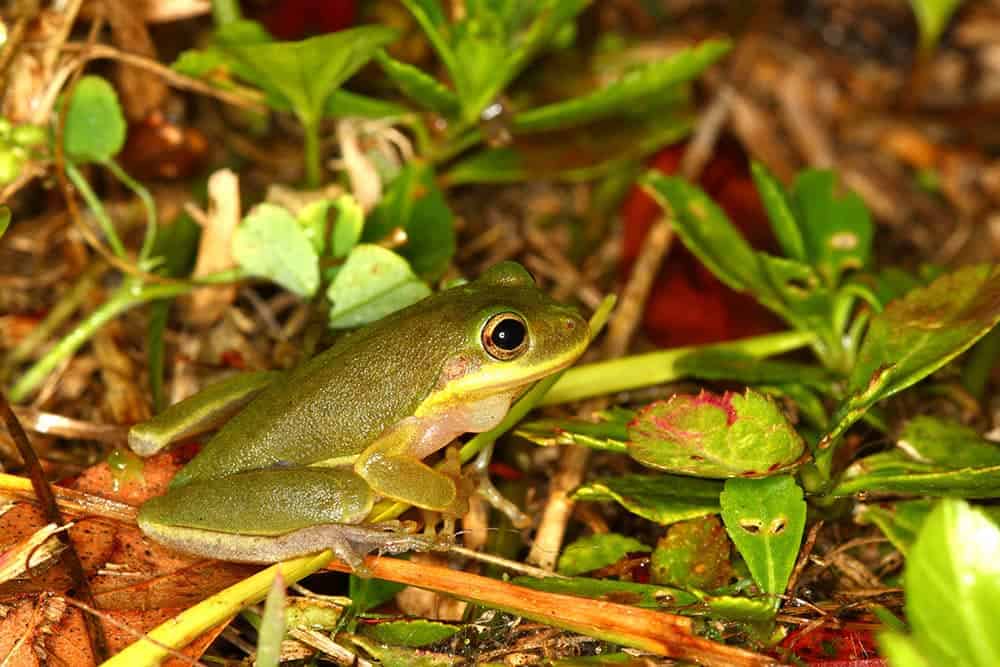
| Species: | Dryophytes squirellus |
| Longevity: | 8–9 years |
| Good to own as a pet?: | No |
| Legal to own?: | Yes |
| Adult size: | 1–2 inches |
| Diet: | Carnivorous |
The Squirrel Tree Frog is from Southern Georgia, and while you can find it In several colors, it is usually green, which causes many people to confuse it with the American Green Tree Frog. It’s an aggressive predator that likes to hang around porch lights to catch insects easily.
14. Little Grass Frog
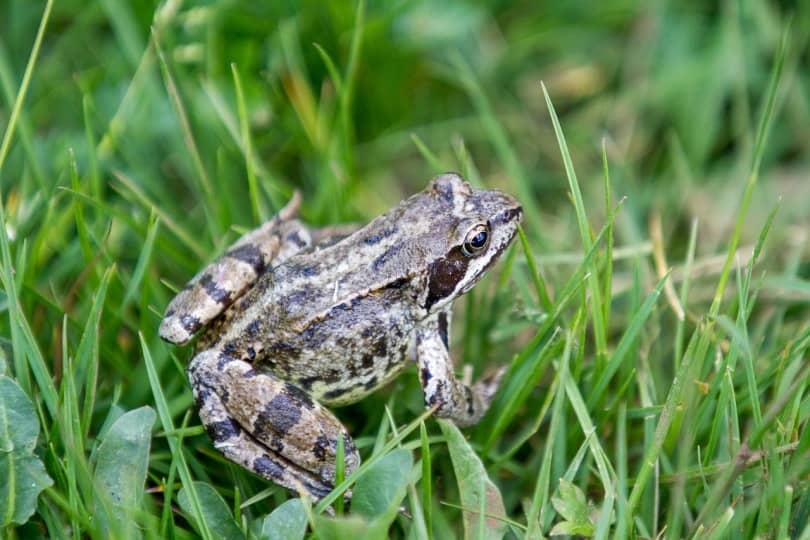
| Species: | Pseudacris ocularis |
| Longevity: | 7–8 years |
| Good to own as a pet?: | No |
| Legal to own?: | Yes |
| Adult size: | < 1 inch |
| Diet: | Carnivorous |
The Little Grass Frog is the smallest frog in North America, rarely growing larger than .75 inches. It’s a pale brown color and likes shallow, grassy water. You can often find them in ditches on the side of the road after heavy rain.
15. Pig Frog
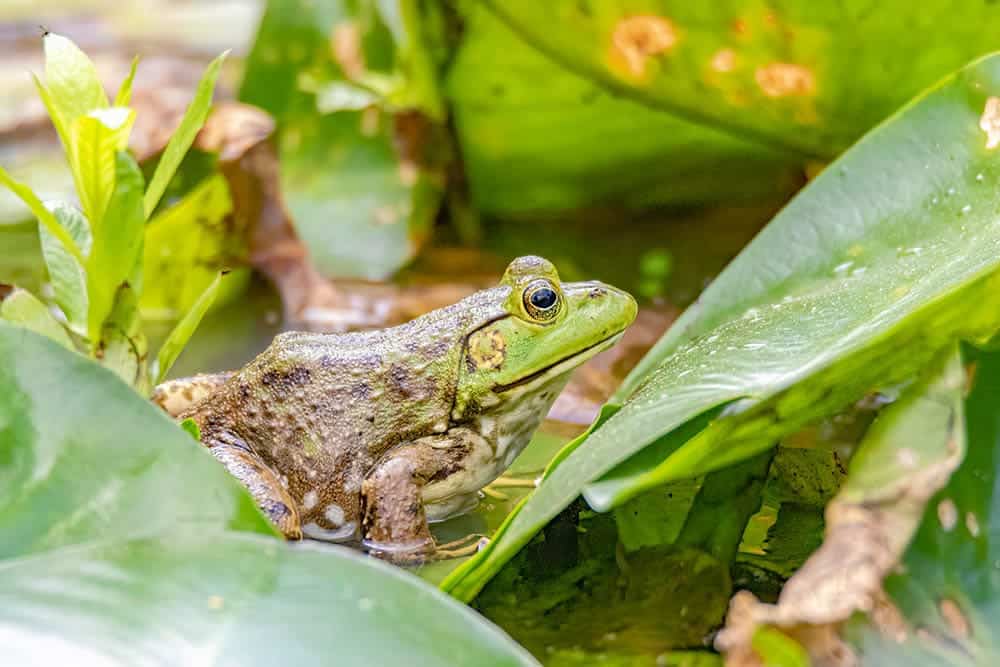
| Species: | Lithobates grylio |
| Longevity: | 7–8 years |
| Good to own as a pet?: | No |
| Legal to own?: | Yes |
| Adult size: | 3–6 inches |
| Diet: | Carnivorous |
The Pig Frog can grow quite large. It has a green or gray color with brown or black splotches and a pointy nose. It’s often mistaken for other frogs found in the same area, like the American Bullfrog, but you can identify it by its deep snorting sound that sounds similar to a pig.
16. River Frog
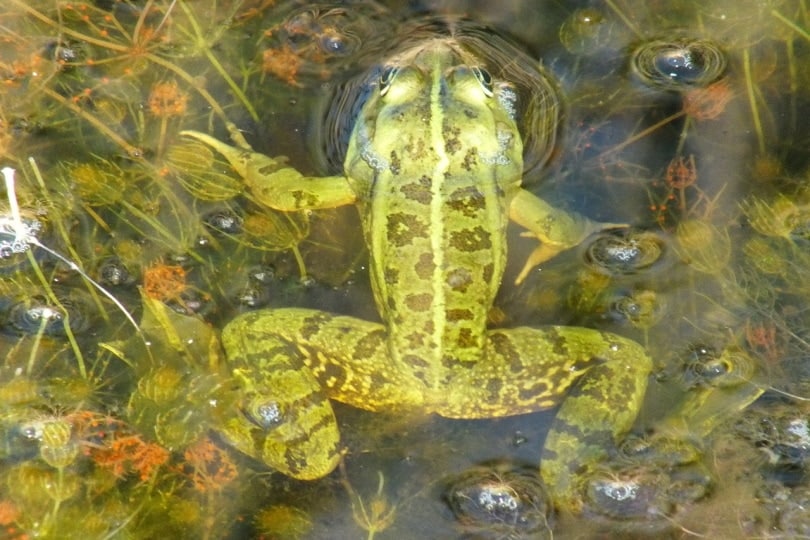
| Species: | Lithobates heckscheri |
| Longevity: | 3–5 years |
| Good to own as a pet?: | No |
| Legal to own?: | Yes |
| Adult size: | 3–5 inches |
| Diet: | Carnivorous |
The River Frog is an aquatic frog from the Southeastern United States that you can usually find around rivers, swamps, and marshes. Its numbers are on the decline due to habitat loss though it is not currently in danger. It prefers Southern Georgia, but you can often find it up north as well.
17. Bird-Voiced Tree Frog
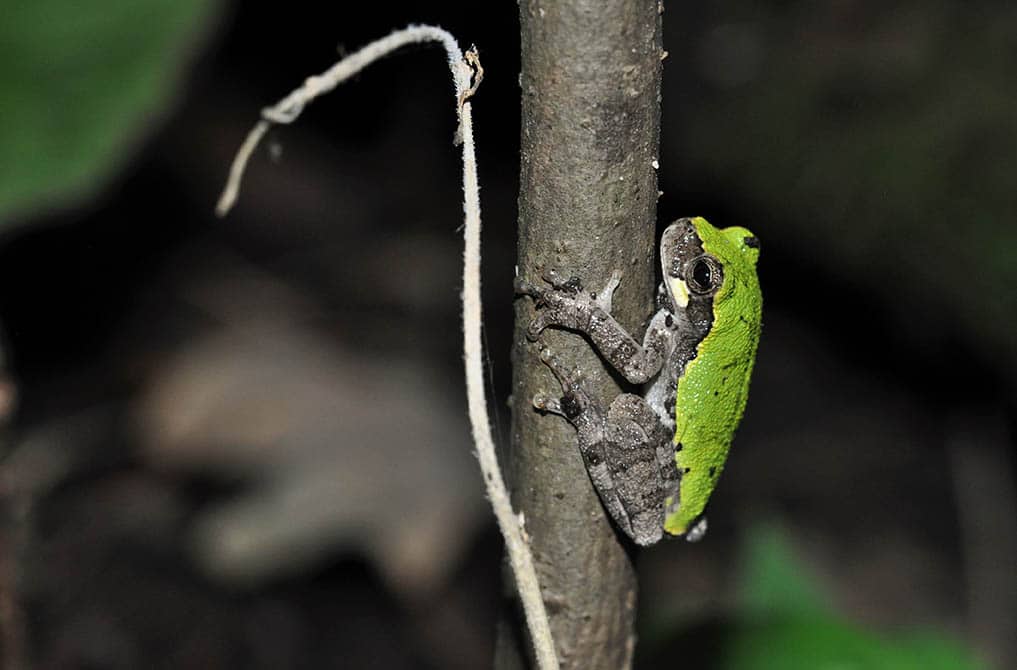
| Species: | Dryophytes avivoca |
| Longevity: | 2–3 years |
| Good to own as a pet?: | No |
| Legal to own?: | Yes |
| Adult size: | 1–2 inches |
| Diet: | Carnivorous |
The Bird-Voiced Tree Frog has an interesting color pattern where the legs and lower parts of the body are grey or brown, while the back will be bright green. It’s a nocturnal frog that spends most of its life high in the trees, only coming down to breed by the water.
18. Cuban Tree Frog

| Species: | Osteopilus septentrionalis |
| Longevity: | 5–10 years |
| Good to own as a pet?: | Yes |
| Legal to own?: | Yes |
| Adult size: | 2–6 inches |
| Diet: | Carnivorous |
The Cuban Tree Frog is an invasive species, and you can find small populations throughout Georgia. It can grow quite large and will eat the local tree frog population, dramatically reducing their numbers. However, despite its problems, the Cuban tree frog makes a great pet, and you can usually find them in your local pet store.

The 4 Types of Frogs in Georgia
1. Poison Frogs
Luckily there is only one species of poison from in Georgia, and it is the Pickerel Frog. The venom this frog produces helps keep snakes and other predators away, and it can cause some minor skin irritation to humans, particularly if you handle it frequently. However, as long as you don’t get toxins in your eyes or other sensitive areas of your body, there is no danger from these frogs.
2. Small Frogs
There are several small frog species in Georgia, including the Spring Peeper, Gray Tree Frog, Little Grass Frog, and others. If you like spotting small frogs, Georgia is a great place to do it.
3. Big Frogs
The American Bullfrog, Bronze Frog, Pig Frog, and Cuban Tree frog are the largest frogs you will likely see in Georgia. The American Bullfrog is the largest, often growing 9 inches and weighing more than 1.5 pounds.
4. Invasive Frogs
The Southern Leopard Frog and the Cuban Tree Frog are the two species of invasive frogs that you want to look for while you are in Georgia. If you notice a large population, we recommend contacting the local wildlife commission.

Conclusion
As you can see, there is no shortage of frog species that you can find in Georgia. The south has a wider variety, but the central and north parts of the state have a few species you can’t find in the south, so it’s worth exploring the whole thing. We hope you have enjoyed reading over this list and found a few you hadn’t heard of before. If you have learned something new, please share this guide to the frogs found in Georgia on Facebook and Twitter.
Check out more fun frog reads below!
Featured Image Credit by Jay Ondreicka, Shutterstock
